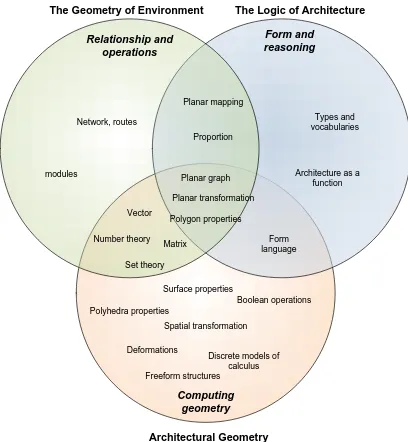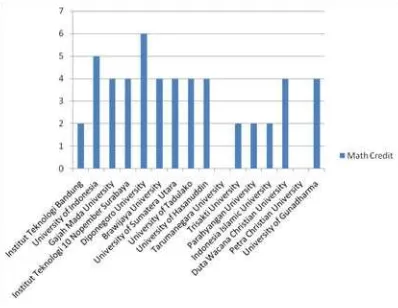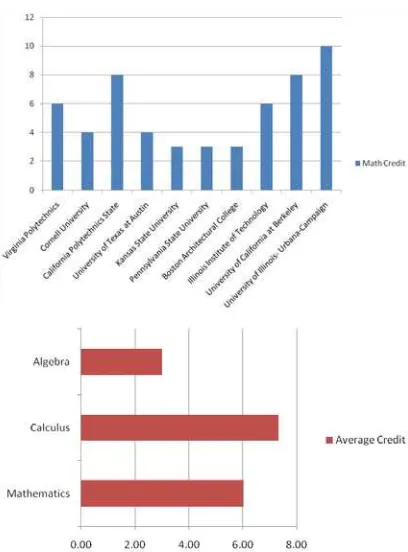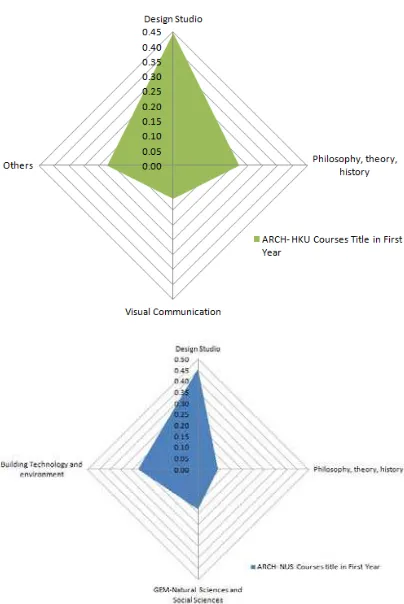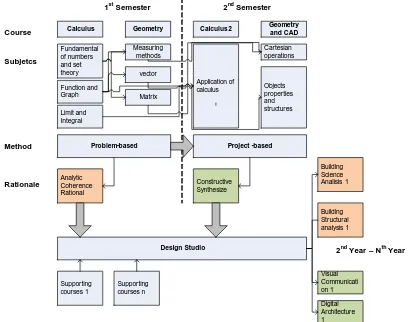MATHEMATICS COURSES AND NEW EMERGING DESIGN TOOL
AN OVERVIEW OF ARCHITECTURAL EDUCATION IN INDONESIA
Aswin Indraprastha
Graduate Student on Design Computing, Department and Engineering, Shibaura Institute of Technology, Japan Department of Architecture, Institut Teknologi Bandung
Email: [email protected]
ABSTRACT
Since the beginning, mathematics courses are inherent within architecture education. In Indonesia, the legacy from Dutch education system has influenced most of the architectural schools and this courses stand as one of basic engineering courses for architecture education system. This situation has been remaining well adopted until recently, some of architectural schools are tailoring mathematics to shape with contemporary challenges particularly regards to the digital tools. This paper aims to present brief information about mathematics courses in architectural schools in Indonesia, the importance of mathematics in learning digital design tools and propose thoughts to upgrade mathematics content in architectural education towards new emerging design tools.
Keywords: Architectural education, mathematics, digital design tools.
Abbreviation
UIA Union Internationale des Architectes–
International Union of Architects
ACSA Association of Collegiate Schools of Architecture
EAAE European Association of Architectural Education
NCARB National Council of Architectural
Registration Boards
IAI Ikatan Arsitek Indonesia–Indonesian
Institute of Architect
INTRODUCTION
Mathematics courses in architecture schools in Indonesia
Historically schools of architecture in Indonesia are parts of engineering faculty and thus give a condition that mathematics and other natural sciences subjects are compulsory at undergraduate level. At most of these schools, the mathematics courses are subject of mathematician with no intention to co-relate this subject to architecture design or intention to understand the particular mathematics that architecture need for practices. This long-standing condition although well accepted as a foundation and general knowledge, has several aspects from which inspired some schools to re-evaluate mathematics courses:
• Program, syllabus and methods from other
department (mostly from Mathematics) usually fixed as they were and these are hard to manipulate according to architectural design requirements.
• Outcome of the contents of mathematics courses
are taken for granted in assumption that mathematics subjects are already fulfill the requirements for rational and analytical thinking required at the subsequent year in architectural level of study.
• Outcome of mathematics courses often
overshadowed by market-oriented computer skilled of junior architects and collaboration-style of working practice where architect is no longer required to do technical analysis.
• Faculties have lack abilities to formulate strategies
for bridging academic knowledge and values with professional practices through mathematics without losing grips in both.
Literature Review on Mathematics for computer-based design education
the Synthesis of Form (Christopher, A.. 1964), The Geometry of Environment (March, L., Philip S., 1971)
and later, The Logic of Architecture (Mitchell, W. J. 1996). By using comparison study of the subjects, diagram below shows the distribution of mathematics subject.
Architecture as a function
Computing geometry Spatial transformation
Discrete models of calculus
The Geometry of Environment The Logic of Architecture
Architectural Geometry
Figure 1. Distribution of mathematics-related
subjects in the three books on the relationship between mathematics and architecture (Source: Author)
As an approach for utilizing CAD system to understand geometry and later on Calculus, the book promotes new methods on learning mathematics by using examples of constructing geometries. Some of the common geometry operations in CAD such as
Boolean and deformation might be hard to explain in
classical ways. However, logic of geometries construction is one of the advantages mathematics abilities students have to master in computing process.
For example, the very basic orientation system in any CAD software is the coordinate system and properties of object.
To understand how computer constructs geometry, the concept of Cartesian coordinate along with its operations are the main operator while point (vertex), line (edge), and surface (polygon) are the operand from which all the complexity may arise. This modeling technique is quite different with physical scale models in term of their abstract nature. Computer needs a translation of data into structured information that can be represented as visual objects.
The well-known Portuguese architect Alvaro Siza whom interviewed by Portuguese Association of Mathematics Teacher once noted that what was important about learning mathematics in architecture was the habit of thought and the clarity of ideas. He thought that this came very much from the study of differential and integral calculus (Brange, J., et.al. 2002). This point is very much emphasizing on what most of architectural schools provide nowadays even though they provide additional course on design-based mathematics. The formation of mind and discipline to look into problem rigorously are some legacies from classic mathematics schools of taught.
X Axis
Figure 2. Basic coordinate system and object properties
in CAD (Source: Author)
Method of study
A desk survey is carried out within scope of this article by collecting data from internet and other literature resources in order to obtain clear picture of mathematics courses in architectural schools in Indonesia. In addition, I gather necessary data from various selected architectural schools from United States, Europe and Asia.
Descriptive analysis
is important fact which drives the direction of most of architectural schools in Indonesia.
According to UIA, architectural education involves the acquisition of the capabilities that categorized into design, knowledge and skills. From these objectives, although not explicitly stated, the followings are abstraction of logical and analytical thinking:
• ability to think three dimensionally in the
exploration of design
• ability to apply analysis and formulate strategies
for action
• understanding the processes of technical design
and the integration of structure, construction technologies and services system into a functionally effective whole
• have skill to communicate ideas through
collaboration, speaking, numeracy, writing, drawing, modeling and evaluation
Analysis from these schools showed that to obtain degree of Bachelor Engineering in Architecture, a full-time study of 8 semesters with average of 144.6 of total credits are required. From these at average 3.19 credits is the provision of mathematics courses in first year level.
Figure 3. (Left) Distribution of the credit of
mathematics courses (Right) Composition of the title of the courses (Source: Author)
As for the distribution of mathematics subject among the schools, 62.5% (from 16 of observed school) provide mathematics and geometry courses, and 18.75% provide calculus course in first year level. From this picture, most of the schools provide mathematics and calculus courses in the first semester with 13-14 semester hours.
Figure 4. Distribution of contents in three different
courses at first semester (Source: Author)
Generally, group of Numbers and Set Theories and group of Function, Coordinate, Graph theory have the highest priority in both mathematics and calculus courses with the total of 38% and 31% respectively. Some school with calculus course have emphasize on Limit and Integral (84%) while in mathematics course, Matrix and Vector subjects has the total of 46%.
Comparative study in United States, Europe and Asia
For the case of United States, the schools were selected from top undergraduate architecture schools ranking by the Design Futures Council and the Journal of Design Intelligence 2007 (Cramer, J.P.). These schools are also member of the Association of Collegiate Schools of Architecture (ACSA), the institutional body to advance the quality of architectural education.
connections. The acceptable courses include algebra, analytic and descriptive geometry, calculus, deferential equations, linier algebra, trigonometry and all courses for which calculus is a prerequisite.
Analysis from ten of these architecture schools reveals that at average of 171.7 total credit, mathematics courses has average of 5.5 credits in first year or 3% of the total. Courses distribution over two semester falls into three categories: mathematics and geometry, calculus and algebra.
Figure 5. (Left) Distribution of mathematics courses
credit. (Right) Composition of mathematics subjects (Source: Author)
Some schools such as Cornell University and Boston Architectural College are regulate mathematics not as compulsory subject but as elective object or as prerequisite before entering first year education program in architecture (Cornell University Web Site & Boston Architectural College Web Site).
As for the Europe counterparts, a study revealed that from the European Association of Architectural Schools (EAAE) members, 48.2% provide Calculus subject, 55.2% provide Geometry and the rest comprise of Algebra, Trigonometry and Applied Mathematics (Cikis, S., 2008).
Both findings from United States and Europe suggested that general mathematics for high education remain to be valid for the preparation of architecture students in their subsequent years.
In Asia, I choose six schools that has architecture department including Tsinghua University, University of Hongkong, National University of Singapore, Korean National University of Arts, King Mongkut University, and Tohoku University, Japan. Surprisingly, only King Mongkut University provides mathematics course at the department of Architecture. Hypothetically, such condition is due that mathematics as a subject is embedded together with other science subjects such as natural science course in Tsinghua University (6.8% of total credit), Science and Technology course in National University of Singapore (2.4% of total credit).
Moreover, University of Hongkong, Tohoku University and Korean National University of Arts does not explicitly provide any science courses in their syllabus. Detailed courses in first year level shown that in department of Architecture, University of Hongkong, Design Studio has 44% of total 54 credits, Philosophy, Theory and History has 22%, the rest of the courses comprise of Visual Communication and Creative Industries. In National University of Singapore, Design Studio has 45% of total 44 credit in first year level, Philosophy, theory and history has 9%, General Education Module which comprises of Natural Science and Social Science has 18%, and Building Technology and Environment course has 27%.
Although NUS offers three specialized track of Bachelor of Architecture, in the first year level, composition of the courses are remain the same.
Discussion on Mathematics as a Mean to learn computer in architecture education
The background thought of this paper is questioning whether mathematics is a necessity to leverage understanding and knowledge of computer-related courses. The initial answer of this question from the point of view of architecture design is obvious as shown by data from various schools in recent curriculum, particularly in the North America and Europe. Regardless the current trends in the leading architectural schools in Asia, it still needs further investigation to address elaborated reasoning when confronted with what kind of mathematics subjects are suitable for learning the digital design tools.
Figure 6. Composition of the courses at first year
level in Department of Architecture. (Left) Department of Architecture, University of Hongkong; (Right) Department of Architecture, National University of Singapore (Source: Author)
This issue however, tries to evaluate and re-establish notion of design-oriented mathematics or mathematics for architecture as one strategy to tailor mathematics in architecture education particularly to prepare students on regards of the new design pedagogy based on information technology. According to new concept of design pedagogy, the new relation between digital form and digital process are demonstrated by Computer Aided Design (CAD) and Digital Architecture Design (DAD) tools, are contributing to the emergence of new conceptual vocabulary and domain knowledge (Oxman, R. 2008).
As most of the researchers and educators in CAD were primary concerned with the technicalities of converting design ideas into design tools, none, if any, was also concerned with using those tools to actually design (Terzidis, K., 2006). Moreover, apparently, the design sensitivities involved in creating this tool are not the same as those involved with using one. The high potentiality of this new tool brought a high expectation of how to change the way
designers work, create and think. Therefore, a paradigm shift was sought from within designer’s world, one that would occur by employing the newly created CAD tools. But this expectation is rather far from the anticipation as I found and explain later on.
Commonly most of architecture educators in Indonesia regard CAD as a conventional design method with new tools while DAD is an entirely new concept and design method using new tools. This transformation requires not just the media and the design process itself, but architectural knowledge base as the foundation of design pedagogy in architecture.
Beyond the exploitation of digital media as a tool, the relationship between digital design and its model as a form of architectural knowledge has begun to emerge as a significant ideational resource for design and design education (Lynn, G., 1999). As a result of the growth of a new knowledge base beyond the skill set of the digital designer, architecture as a design discipline has became rich in ideas, changing methodologies, and unique bodies of conceptual content (Reiser, J., Umemoto, 2006). In European architectural schools, recent study revealed that the content of CAD-based education tends to be quite technology oriented. Course objectives quite often seem to be rather CAD specific and the education given does not necessarily respect architectural objectives or the needs of architectural design education (Pentilla, H., 2003). On the mental aspects of the architectural and information technology, the motivation to learn CAD and information technology seems to have been always high among the architectural schools.
Real Issues and Challenges
Recent findings of the condition in Indonesia reveal two facts: first, due to high demand on IT-skilled of the bachelor of architecture in Indonesia, universities have several strategies to upgrade their students with computer skills. The most adopted strategy is to provide practice-based course in computer lab. Another is to provide CAD and Computer Graphics courses as a mixed between software’s know-how and practice, provide CAD courses as elective course and let students determine to learn software independently. Second, based on the study from one of architectural school in Indonesia, it shows that the most motivation of the students to learn CAD is to do with design production, hence for the drafting purposes (Mintorogo, D. S., 2001). This condition is due to several factors namely:
• No linkage between CAD course and Design
• Lack of skill to transform knowledge from CAD into the application in design process. This transformation requires not only technical skill but also cognitive ability
This two contradictory situation would endangered the architectural professional practice as a whole since IT-related provision is not well equipped with sufficient domain of knowledge.
Based on those facts it is clear that course in analytical logic has to improve and to upgrade in order to provide sufficient fundamental knowledge for computer-related design processes. The provision of mathematics is quite important to bridge between newly design tools and architecture design. As been shown in previous study, the synergy between theory-based courses and practical-theory-based studio is significant factor to engage knowledge, skill and the development of cognitive abilities.
As far as we know, there are two challenges of mathematics courses in architectural education: first, regards to the construction of form by means of digital tools. Second, regards to the analytical thinking beyond form generation processes.
Framework of Application
In the application, relationship between computer as design tool and discipline of architecture can be interpreted according two paradigm (Kalay, Y.E., 2004). First, is that of “forcing a square peg into a
round-hole,” which implies that the use of the new
tools is misdirected or at least poorly fits the processes that have traditionally been part of architecture design. As a result, the quality of architectural practices will degrade. Under this paradigm, it requires a clear identification of the different actions that comprise the design process and assign computational tools as aiding devices. The second paradigm describes a state of transformation where new technology is viewed through the lens of the current, obsolescent practice and labeled in essentially ‘backward’ terms. It implies a lack of appreciation for the potential of the emerging technology.
From what it is found, most architectural schools in Indonesia try to maximize knowledge and skills by maintaining general mathematics and calculus as required in general engineering courses and CAD-based course with emphasize on the closed relation with design studio. While CAD-based courses are still developing its own knowledge contents, it is worth considering that the purpose of learning computer in design studio is not just as extension of conventional
tools with all the advantages, but more the novelty is to encourage creativity through understanding of mathematics, particularly geometry, in the computer aided design software.
Calculus
1stSemester 2ndSemester
Course
courses 1 Supporting courses n
Figure 7. Framework concept of the application
As seen from figure above, mathematics as general requirement for engineering and architecture student remains fundamental while with the same purpose, gives opportunity to encourage development of cognitive ability through computer-based learning. In this concept, architecture education utilizes mathematics both as methods for analytical thinking and method for constructive thinking by mean of digital tools. The significant of first year relies on the fact that Design Studio is the core of education in subsequent years and all of fundamental courses will be regarded as supporting contents. Without gives an equal emphasize both on analytic and constructive abilities, the result of the product of architectural education will remain the same as evidenced by previous study.
CONCLUDING REMARKS
it is worth considering the root of how the computation works and how it will transform the way designer look on to the problem, analyze the possible solutions and execute design strategy using new method and new tools. The issue, however, is no longer on the ability of synthesizing abstractions into physical and concrete design solutions between digital and non-digital but rather, on the ability to handle information in it’s various forms using analytical and rational thoughts which are mostly came from the advancement of mathematics.
Mathematics courses in architecture education has to adapt to new recently developing software for design process and design production and, if not an obligation, should be overhauled and upgraded because computer and information technologies have come to affect architecture just as in other areas in our lives. Even though most of the digital application today in the architectural education in Indonesia is purely a presentation tool, it later has quickly become an inseparable part within design process. When information technology becomes a part of the social infrastructure, it demands design consideration from a broad range of disciplines, including the foremost, architecture (McCullough, M., 2005).
It will need more than an addition of computer-related subjects to the curriculum of architectural education or add mathematics courses as a basic engineering course. The mathematical foundation of digital technologies which is new in architecture education, has to be an important point to develop the concept of architectural education system which regards computation as an enabler of creativities and analytical thinking to outreach beyond its numerical and geometrical establishment.
Firstly, we must consider the first year of education system that compose 36-40 credits as a foundation of thinking toward the design studio as core of curriculum. By this consideration, it is necessary to develop new function and meaning of mathematics as one of this foundation. And, as design studio is more and more geared up with the new digital tools, the role of mathematics course is inseparable and falls into two rationales: analytic and
constructive as illustrated in Figure7.
Secondly, we must review the content of mathematics courses, whether it is in separated courses under the title of calculus, mathematics or blended as a package of basic engineering course under the consideration stated above. This would re-validate the nature of the relationship between mathematics and architecture as it has been in early middle Ages where the role of mathematics had
prominent in design process. Now the challenge is the mathematics embodied in digital technologies.
Acknowledgement
Author would like to thank these following fellow scholars: Mr. Devin Defriza Harisdani ST., MT. (Universitas Sumatera Utara), Dr. Arief Kusumawanto (Universitas Gajah Mada) and Mr. Ir. Raziq Hasan, MT. Ars. (Gunadharma University) for their generous contribution in providing data of Mathematics Syllabuses to be included in this paper.
REFERENCE
Boston Architectural College Web Site, http://www. the-bac.edu/x244.xml
Brange, J., et.al. (2002) “Mathematics in the Architecture Curriculum,” Nexus Network
Journal, vol. 04 , no.1.
Christopher, A. (1964) Notes on the Synthesis of
Form, Harvard University Press.
Cikis, S. (2008) “A Critical Evaluation of Mathematics Courses in Architetcural Education and Practice,” International Journal of Technology
and Design Education, Online First, http://www.
springerlink.com/content/102912/?Content+St atus=Accepted
Cornell University Web Site, http://www.aap. cornell.edu/arch/programs/ugcurriculum.cfm
Cramer, J.P., “The Top U.S. Architecture Schools,” http://www.architectmagazine.com/indust ry-news.asp?sectionID=1006&articleID= 602885.
Directorate General of Higher Education, “List of Indonesian Universities,” http://www.dikti.go.id/ index.php?option=com_content&task=view&i d=140&Itemid=61 accessed on July 2009.
Education Standard, National Council of Architectural
Registration Boards Education Standard,
pp.7-8, 2008-2009, www.ncarb.org
Kalay, Y.E., (2004) Architecture’s New Media, TheMIT Press.
Lynn, G. (1999) Animate Form. Princeton Architectural Press.
March, L., Philip S. (1971) The Geometry of
Environment, The MIT Press.
Mintorogo, D. S., (2001) “The Phenomena of Teaching CAAD and Multimedia in Architecture Education at Petra Christian University” Dimensi (Journal of Architectural
Engineering), Petra Christian University, vol.
29, no. 2.
Mitchell, W. J. (1996) The Logic of Architecture, The MIT Press.
Oxman, R. (2008) ”Digital Architecture as a Challenge for Design Pedagogy: Theory, Knowledge, Models and Medium,” Design
Studies 29, pp. 99-120.
Pentilla, H. (2003) “Architectural-IT and Educational Curriculum–A European Overview,”
Architectural Computing IJAC, vol. 01, no.1.
Pottmann, H., et.al. (2007) Architectural Geometry. Bentley Institute Press.
Reiser, J., Umemoto (2006) Atlas of Novel Tectonics. Princeton Architectural Press.
Terzidis, K. (2006) Algorithmic Architecture. Architectural Press.
